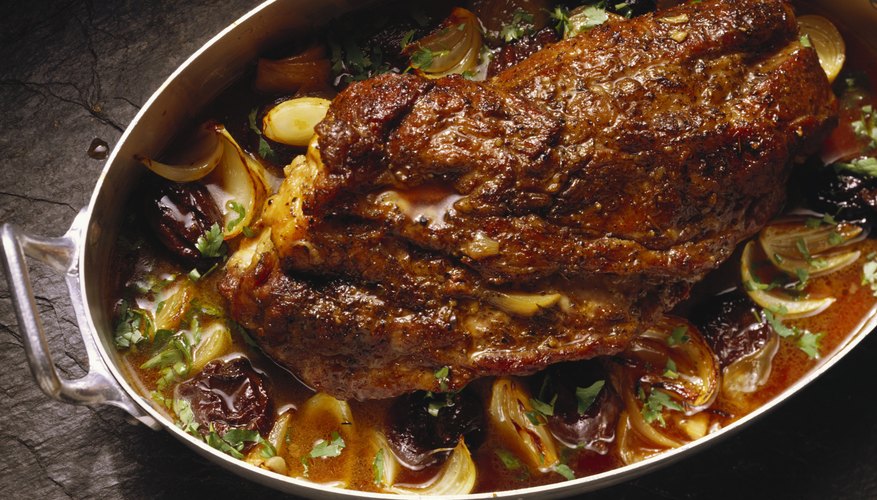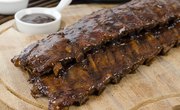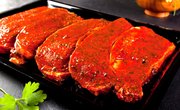
Pigs are among the most adaptable and self-reliant of domesticated animals, and native or feral wild pigs are correspondingly common in much of the world. In the U.S. most wild pigs are feral descendants of escaped domestic animals, though European wild boar is farmed for sale to pork enthusiasts. The meat of farmed or feral wild pig is leaner and more flavorful than ordinary pork, but you can cook it in most of the same ways.
Fire Up Some Smoke
Unsurprisingly, one of the most alluring ways to cook wild pig is as traditional barbecue. Slow-cooking the animal -- whole, or in pieces -- over coals and smoke complements its own rich flavors, and avoids toughening the lean meat. Brining the pig first adds flavor and helps keep it moist. For a whole hog you'll need a large cooking pit, either made commercially or improvised with cinder blocks. For smaller pieces, such as a shoulder, an ordinary barbecue or smoker works fine. At a temperature of 225 degrees Fahrenheit or lower, a shoulder can take eight to 12 hours and a whole hog can take 14 to 18. Smaller cuts such as ribs might need as little as three to four hours.
Roasts
Wild pig also makes a fine and exceptionally flavorful roast. Because of its leanness it should be roasted at lower temperatures than regular pork, and the modern slow-roasting technique -- 225 to 250 F for several hours -- gives the juiciest, tenderest result. The loin and rib sections are tender, just as they are on domesticated animals, and are best at the 145 F temperature used for regular pork. Tougher cuts such as the shoulder and leg are sometimes better if slow-roasted to well done, at 180 F or higher, which dissolves the tough connective tissues and softens the muscle. The U.S. Department of Agriculture recommends cooking all game animals, including wild-caught pig, to a final temperature of 160 F or higher.
Hot and Fast
The tenderest cuts of wild pig, including the tenderloin, loin and rib sections, also lend themselves well to grilling, broiling, frying and similar high-temperature cooking techniques. In this case, you compensate for the meat's leanness by shortening the cooking time rather than by reducing the temperature. Tenderloins can be grilled and broiled whole, or sliced into medallions for grilling. Loin and rib chops can be treated much the same as the comparable pork chops, bearing in mind that they'll require a minute or two less on each side because of their leanness. A loin roast, with its protective fat cap trimmed to roughly 1/4 inch, can be roasted at 425 F until its internal temperature reaches 145 F.
Braising and Stewing
As an alternative to barbecuing or slow roasting, tough cuts from the leg and shoulder can also benefit from braising or stewing. Both methods simmer the wild pig gently in broth or sauce for hours until tender, so the difference is largely one of terminology. If you're cooking a single large cut such as a roast it's considered braising, and it's stewing if you work with fork-sized, cut-up morsels. In either case you'd brown the wild pig first, then place it in an oven dish or slow cooker with broth, wine, a prepared sauce or other liquid. After several hours of slow simmering in the oven or on your counter, the meat is tender and delicious and the cooking liquids, once strained, and thickened, make a fine sauce.
References
- Larousse Gastronomique, Prosper Montagne, Ed.
- U.S. Department of Agriculture Food Safety and Inspection Service: Game From Farm to Table
- Amazing Ribs: Perfect Pulled Pork
Resources
Writer Bio
Fred Decker is a trained chef and prolific freelance writer. He grew up in rural Nova Scotia, and had learned to skin a rabbit with his pocketknife by the age of seven (whenever the pocketknife wasn't lost). He was educated at Memorial University of Newfoundland and the Northern Alberta Institute of Technology, and seldom loses a pocketknife anymore. You'll find his articles on game, foraged foods and other outdoor topics at major sites including eHow, Leaf.TV, Livestrong, OurEverydayLife and many others.



